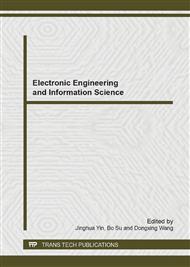[1]
Shen X J, Wang G Y, Wang L D, et al. Effect Evaluation for Electronic Jamming Aircraft against Netted Surveillance Radars [J]. Journal of System Simulation 2008, 20(4): 997-1000.
Google Scholar
[2]
Frank W Moore. Radar cross-section reduction via route planning and intelligent control [J]. IEEE Transactions on Control Systems Technology, 2002, 10(5): 696-700.
DOI: 10.1109/tcst.2002.801879
Google Scholar
[3]
K. Misovec, T. Inanc. Low-Observable nonlinear trajectory generation for unmanned air vehicles [J]. IEEE Conference on Decision and Control, 2003, 12: 3103-3110.
DOI: 10.1109/cdc.2003.1273100
Google Scholar
[4]
Tamer Inanc, Kathy Misovec, Richard M. Murray. Nonlinear trajectory generation for unmanned air vehicles with multiple radars [J]. IEEE Conference on Decision and Control, 2004, 12: 3817-3822.
DOI: 10.1109/cdc.2004.1429333
Google Scholar
[5]
Xing M L, Xiao J P. Research on Cooperative Jamming in Complex Electromagnetic Environment [J]. Journal of Telemetry, Tracking and Command, 2010, 31(4): 30-35.
Google Scholar
[6]
Li B, Gao X G. Algorithm of power allocation for cooperative electronic jamming in air combat of formation [J]. Journal of Systems Engineering and Electronics, 2008, 30(7): 1298-1300.
Google Scholar
[7]
Rao D H, Huang G M, Chen Q. Route Planning of Low-Altitude Penetration with Cooperation of Electronic Jamming [J]. Electronic Optics &Control, 2010, 17(5): 18-21.
Google Scholar
[8]
Shi H S, Li D, Zhao Z G. The Simulation and Research of Electronics Jamming Influence on Radar Net Detection Space and Flight Path Planning of Aircraft[C]. International conference on radar. Shanghai: IEEE press, 2006: 1-5.
DOI: 10.1109/icr.2006.343331
Google Scholar
[9]
Li Y Z, Wu D J, Hou H Q, et al. Simulation Analysis on Track Program That 3-plane Jamming and Suppressing The Netted Radar[J]. Shipboard Electronic Countermeasure. 2008, 31(1): 39-42.
Google Scholar
[10]
Mingyan Li, Lordanis Koutsopoulos, Radha poovendran. Optimal jamming attack strategies and network defense policies in wireless sensor networks [J]. IEEE Transactions on Mobile Computing, 2010, 9(8): 1119-1133.
DOI: 10.1109/tmc.2010.75
Google Scholar
[11]
Christina Popper, Mario Strasser. Anti-jamming broadcast communication using uncoordinated spread spectrum techniques [J]. IEEE Journal on Selected Areas in Communications, 2010, 28(5): 703-715.
DOI: 10.1109/jsac.2010.100608
Google Scholar
[12]
S.M. Andraws. Optimal C4ISR networks in the presence of enemy jamming[R]. Naval Postgraduate School: NTIS, (2010).
Google Scholar
[13]
Szczerba R J. Robust algorithm for real-time route planning [J]. IEEE Transactions on Aerospace and Electronic Systems, 2000, 36(3): 869-878.
DOI: 10.1109/7.869506
Google Scholar


